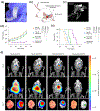Emerging Piezoelectric Metamaterials for Biomedical Applications
- PMID: 40046679
- PMCID: PMC11882151
- DOI: 10.53941/mi.2024.100004
Emerging Piezoelectric Metamaterials for Biomedical Applications
Abstract
Emerging piezoelectric metamaterials hold immense promise for biomedical applications by merging the intrinsic electrical properties of piezoelectricity with the precise architecture of metamaterials. This review provides a comprehensive overview of various piezoelectric materials- such as molecular crystals, ceramics, and polymers-known for their exceptional piezoelectric performance and biocompatibility. We explore the advanced engineering approaches, including molecular design, supramolecular packing, and 3D assembly, which enable the customization of piezoelectric properties for targeted biomedical applications. Particular attention is given to the pivotal role of metamaterial structuring in the development of 0D spheres, 1D fibers and tubes, 2D films, and 3D scaffolds. Key biomedical applications, including tissue engineering, drug delivery, wound healing, and biosensing, are discussed through illustrative examples. Finally, the article addresses critical challenges and future directions, aiming to drive further innovations in piezoelectric biomaterials for next-generation healthcare technologies.
Keywords: 3D assembly; biomedical applications; molecular design; piezoelectric metamaterials; supramolecular packing.
Conflict of interest statement
Conflicts of Interest: The authors declare no competing financial interest.
Figures












References
-
- Evangel Chinyere A; Femi O; Opeoluwa Oluwanifemi A; Jane Osareme O; Tolulope O; Ebere Rosita D Biomedical engineering advances: A review of innovations in healthcare and patient outcomes. Int. J. Sci. Res. Arch 2024, 11, 870–882.
-
- Yi J; Zou G; Huang J; Ren X; Tian Q; Yu Q; Wang P; Yuan Y; Tang W; Wang C; et al. Water-responsive supercontractile polymer films for bioelectronic interfaces. Nature 2023, 624, 295–302. - PubMed
-
- Chen S; Tong X; Huo Y; Liu S; Yin Y; Tan ML; Cai K; Ji W Piezoelectric biomaterials inspired by nature for applications in biomedicine and nanotechnology. Adv. Mater 2024, 36, e2406192. - PubMed
Grants and funding
LinkOut - more resources
Full Text Sources
